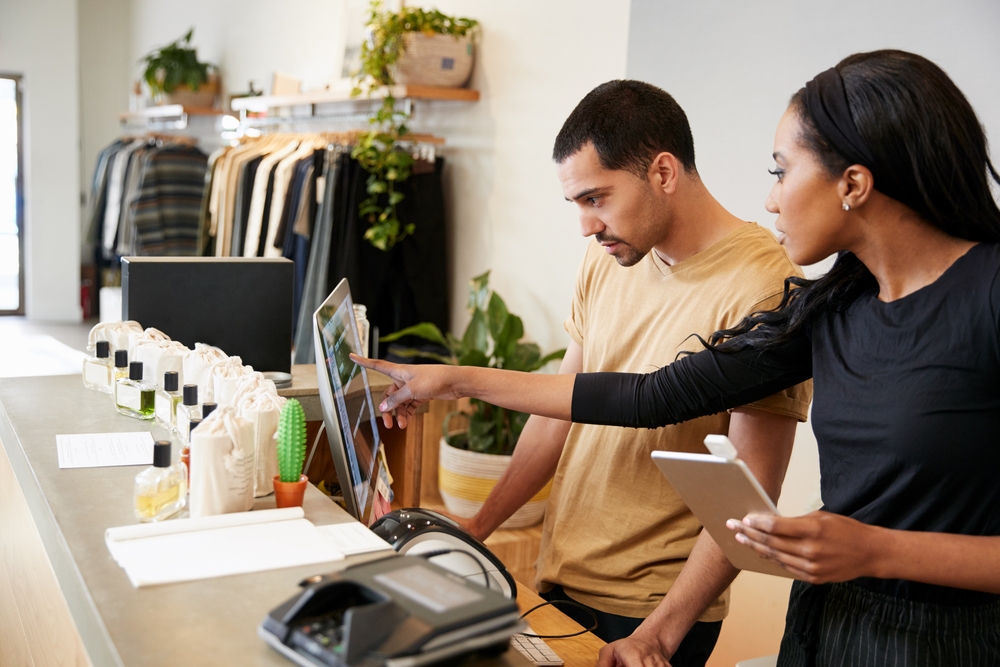There’re new options at checkout these days, which is great news for retailers as well as consumers who really, really want that KitchenAid, but don’t have the cash on hand and don’t want to add to their credit card debt.
Indeed, over the last several years, a third rail payment option has emerged, Point-of-Sale (POS) loans, wherein third-party loan providers partner with merchants to provide customers with a layaway-like payment plan.
Consumers are given the option of breaking their purchase into interest-free installments (as long as they don’t miss a payment), expanding their purchasing power while not expanding their credit card debt. This is obviously a boon for retailers and retail, but one that comes with a new set of challenges. How can retailers maximize the rewards while limiting the risks of this developing payment model?
Well, dear reader, great news: your credit is always good with us—in fact, you’re pre-approved! So, get ready to shop ‘till you drop, we are loading up on retail market research to understand this emerging financing option, what it means for brick & mortar and digital retail alike, and reassess US consumers, their credit score, and their appetite for debt (they’re full).
POS Loans: The Modern Day Layaway
Yes, this is, in a way, just a fancy newfangled way to do layaway, the classic payment system by which your parents likely got their washing machine.
There are a few key differences, however, some structural, some technological. The first is the size: these loans aren’t just on big ticket items that cost more than the average savings account holds. Instead these are loans sometimes as small as $150 for pairs of Joe’s Jeans or Jordans. Or, say, you have been coveting the same gosh darn pair of camel colored Salvatore Ferragamo driving shoes for the better part of a year but known good and gosh darn well that you simply cannot rationalize the purchase without devolving into a shameful profligate with no real claim to adulthood (for example). They’re good for that too.

Second, these loans don’t last very long—POS loans are almost always less than two years and sometimes as short as a couple of months.
Third, these loans are rarely provided by the retailers themselves and the usual credit suspects are nowhere to be found—instead of banks or even credit card companies, new tech startups like Affirm are underwriting the bulk of these loans.
And finally, in twist particularly well suited for our instant-gratification culture, the loans are quick. The technology behind these platforms, combined with new underwriting methods and lower interest rates, means customers can now be approved for financing (at the cash register mind you) in “less than one second.”
Customers also generally take the item home with them once they have signed the loan and made their first payment. The idea of slowly paying off a jacket in the spring so it can be on your back by winter time is something that will likely go the way of the gold standard.
More Loans, More Spending, More Debt, More Everything
How big a deal are these loans? According to one research firm, the point-of-sale financing market is at roughly $391 billion/year industry, which accounts for roughly 3.5% of all annual consumer spending. The biggest retail categories for the industry? Electronics, home goods (thank you for the financing options, Living Spaces, we love the couch!), and health care.
Additionally, more than 25% of customers have already used point-of-sale instant financing when shopping online, and almost half of consumers would like to be presented with the option when shopping.
TransUnion VP Paul Siegried feels the POS loan fever: “As brick-and-mortar retailers continue to face challenges, many merchants are implementing point-of-sale financing alternatives as a potential new avenue for growth.”
Last year, Affirm did $1 billion in POS loans, mainly concentrating on travel, biking, and clothing loans (though, they recently partnered with Walmart to offer POS financing online and in-store, so that may change).
Regardless, their growth, according to founder Max Levchin, has everything to do with millennials, whom he describes as "underbanked." Millennials, of course, have proven somewhat uncomfortable with credit cards and big banks, having seen their parents struggle with debt right around 2008, and many would rather stay ahead of the debt curve.
Levchin observes, “Consumers recognize the need for credit but are unhappy with the terms and lack of control associated with traditional cards.” These pain points have everything to do with fees and interest, which are often cryptic, compounding, and crippling.

That’s why POS loans can be so disruptive—charging the merchants a fee means that consumers who make their payments on time can avoid all of the costs and confusion associated with typical credit cards.
Is Credit’s Future Plastic-Free?
Of course, isn’t a zero-sum game—POS loans don’t have to exist as a binary alternative to credit cards, but can also operate as a compliment, another type of financing available in our credit-happy generation.
There are currently 432 million cards in circulation, up from 279 million in 2010, an increase due to the recession’s recession as well as the war of escalation creditors have launched with expanded rewards and singing bonuses. So, for credit-happy consumers, this is just another way to allow “I want” to silence “I can’t.”
Yet, according to Affirm’s own survey, more than half of consumers 22-44 said they enjoy their purchases less when it adds to their credit card debt, and a whopping 87% (plus a few grains of salt) expressed interest in paying for large purchases via monthly installments a-la Affirm. When asked to identify installments’ most appealing aspects, they zeroed in on transparency—knowing exactly how much they will owe and when.
“We believe the future of credit is not a piece of plastic but an app that gives consumers flexibility to spend where and when they want, along with transparency into the true cost of a purchase,” Levchin said. And it looks like he just might be right.
POS Loans: Costs and Rewards
Merchant fees, which by definition eat into profit margins, can be as high as 10%-20% of the entire loan. Called a “discount fee” this percentage is the reduced cost the loan provider pays for the merchandise while charging the consumer full price—this discrepancy is where the loan provider gets his cheddar, and the steep percentages are starting to cheese retailers off.
But offering rapid, no-cost financing at the point of sale seems to be worth it. According to one Forester study, companies that implemented POS financing option experienced 32% sales increase as well as a 75% increase in order value. Upticks like that can go a long way in helping a retailer swallow a discount fee.

The loans allows existing customers the opportunity to purchase items of greater cost and also brings in new customers who could not have afforded to shop there in the first place. By increasing order value without lowering margins, the loans offer a unique path to increased profitability.
Retail Market Research to Optimize POS Loans
In a welcome turn for almost everybody, technology is now focusing on the marketplace as much as the market, meaning that there are platforms now that allow merchants to compare POS loan offers, forcing loan providers to reduce their discount fees in order to stay competitive. Startups like SuperMoney and GreenSky are already altering the lay of the POS- loan land by pitting lenders against one another.
This is particularly timely as legacy players like banks, looking to diversify their loan books, and credit card companies, always on the lookout for new debt, trip over one another in a race to get into a loan market they fear has already left them behind.
Indeed, JP Morgan is getting in on it with “My Chase Plan” financing options; PayPal is now offering an independent, interest free credit plan; Square (makers of those iPad and IPhone attachments that turn devices into payment centers) are moving into POS loans; and new arrivals like Bisplay and Bread are joining veterans like Affirm.
With so many options, retailers will need to find the best partners for their margins and their customers. They will also need to constantly run retail market research methodologies to optimize their in-store experience, increase sales, and expand their customer base.
And now I’m off to secure a loan for a certain pair of shoes –you know, for research.


